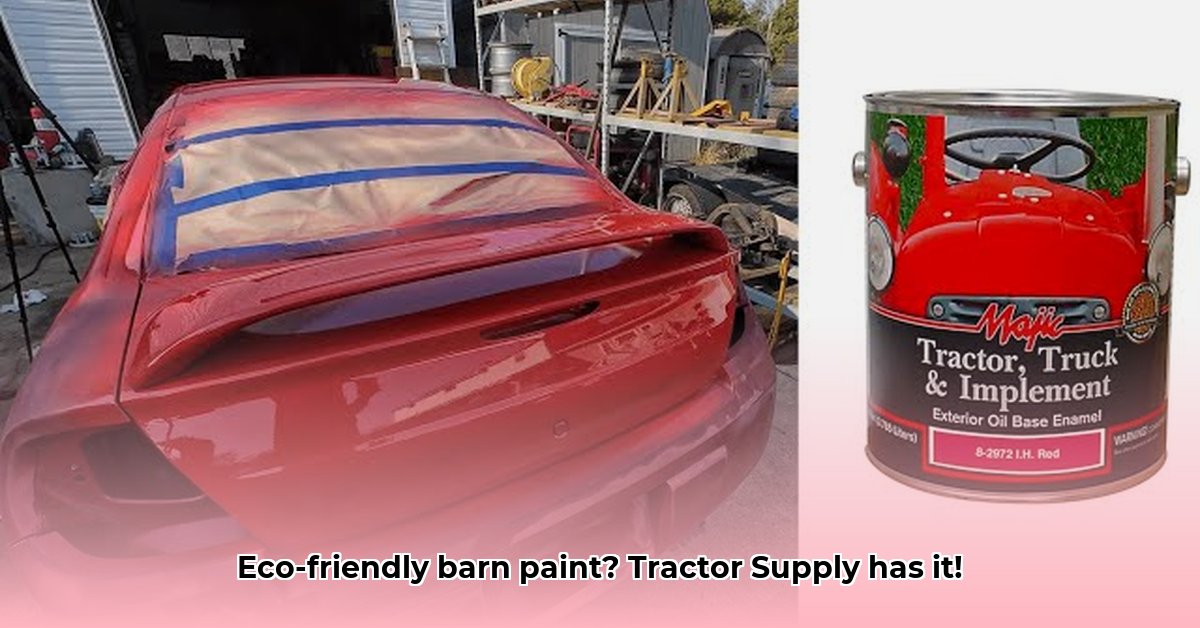
Your barn is more than just storage; it's a symbol of your farm's legacy. Maintaining it sustainably not only protects your investment but also contributes to responsible land management. This guide helps you choose eco-friendly barn paint from Tractor Supply, maximizing both aesthetics and environmental stewardship. We'll cover paint selection, preparation, application, and long-term care, ensuring your barn looks its best while minimizing your environmental footprint.
Choosing the Right Paint: Your Tractor Supply Options
Tractor Supply offers various barn paints, each with unique environmental and performance characteristics. Understanding these differences is crucial for making an informed decision. Do you prioritize ease of application, longevity, or the lowest possible environmental impact? Let's break down your choices:
Low-VOC Paints: These paints release fewer volatile organic compounds (VOCs) – chemicals that can harm air quality and your health. They’re a healthier choice for you and the environment, although they might be slightly more expensive. Is the improved air quality worth the investment? Many farmers would say absolutely.
Water-Based Paints: Generally easier to clean up with just soap and water, water-based paints typically have lower VOCs than oil-based alternatives. However, their durability might be lower, especially in harsh weather conditions. A quantifiable fact to consider: water-based paints often require more coats for complete coverage.
Paints with Recycled Content: These paints incorporate recycled materials, minimizing waste and reducing reliance on virgin resources. They often perform comparably to traditional paints, offering an excellent blend of sustainability and performance. However, availability might vary, and the price can fluctuate.
Here's a comparison table to help you decide:
| Paint Type | Pros | Cons | Cost Range | Environmental Impact |
|---|---|---|---|---|
| Low-VOC | Healthier; often durable | More expensive | $$$ | Excellent |
| Water-Based | Easy cleanup; lower VOCs | May need more coats; less durable in harsh weather | $$ | Good |
| Recycled Content Paint | Environmentally friendly; good performance | Availability varies; price can fluctuate | $$ - $$$ | Excellent |
(Note: Cost ranges are relative and may vary based on quantity and specific product.)
Preparing Your Barn: Sustainable Prep Work
Proper preparation is crucial for a long-lasting, beautiful finish and minimizing waste. It's also key to ensuring the sustainability of your efforts. Here's a step-by-step guide:
Cleaning: Thoroughly clean the barn siding using a pressure washer or scrub brush. Remove all dirt, debris, and loose paint chips. Use a biodegradable cleaner for minimal environmental impact.
Repairs: Address cracks, holes, or damaged wood using an exterior-grade wood filler. Allow ample drying time before painting. This prevents moisture damage and ensures a smooth, even finish.
Priming (if necessary): Priming improves paint adhesion, resulting in fewer coats needed and ultimately less waste. Choose a primer compatible with your chosen paint.
Applying Your Paint: Techniques for Efficiency and Quality
Proper application techniques ensure even coverage and minimize paint waste. Here’s a step-by-step guide:
Gather Your Tools: Assemble high-quality brushes (various sizes), rollers (a long-handled one is helpful), a paint tray, and drop cloths.
Even Coats: Apply thin, even coats using long, steady strokes. Avoid overloading your brush or roller; multiple thin coats are superior to one thick coat.
Safety First: Always wear appropriate protective gear, including gloves, eye protection, and a respirator (especially when using sprayers or paints with stronger fumes).
Post-Painting Care: Maintaining Your Sustainable Finish
Long-term maintenance protects your investment and extends the life of your paint job.
Regular Cleaning: Occasionally wash the barn with a soft brush and eco-friendly cleaner to remove dirt and grime.
Spot Repairs: Address small chips or scratches promptly with touch-up paint to prevent further damage.
Responsible Disposal: Dispose of leftover paint and cleaning materials according to local regulations.
By prioritizing sustainable paints and practices, you're not just enhancing your barn's aesthetic appeal; you're actively contributing to a healthier environment and demonstrating responsible land management. It's a win-win for your farm and the planet.